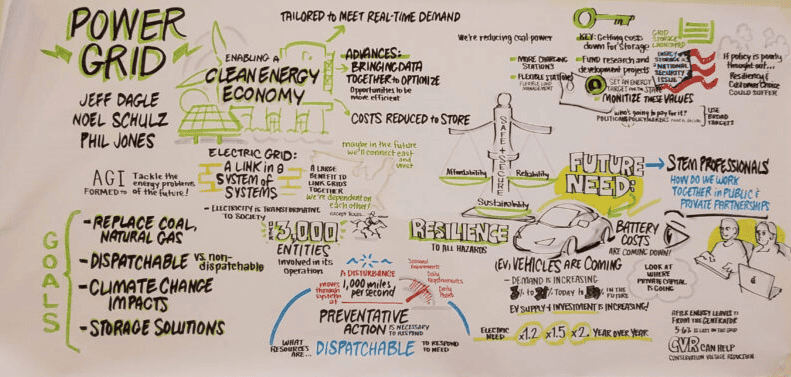

Anil Jampala & Ken Pratt
Utilities around the world are upgrading and optimizing their grid infrastructure. However, between incorporating renewable energy sources, increasing demand for electricity, extreme weather, and numerous vendor solutions, there are many issues to address. The path forward isn’t always clear. Roadmaps are instrumental in ensuring strategic plans and decisions are consistent with the utility’s ultimate future goals.
This is part 1 of a two-part series. Part 2 covers the process and activities for developing a robust roadmap as well as how to leverage one to obtain the maximum benefits.
Upgrading and enhancing the grid is a complex undertaking. With a wide range of issues and potential solutions to consider, moving from point A (i.e., no or low renewables) to point B (i.e., high penetration of renewables) requires careful evaluation and planning. That’s where roadmaps come in. Utilities supply reliable power to thousands of customers every day; however, they often look for assistance to understand and evaluate the latest available technologies and trends to optimize the grid effectively.
Through a requirements and gap analysis, a consulting service provider can identify the utilities requirements and goals to isolate the gaps between a utility’s current operations and their objectives. Put simply, they help the utility pinpoint what needs implementing, replacing, upgrading, or changing and identify who has the products, services, and strategies necessary to accomplish these goals.

This image is used with PNNL/WSU Advanced Grid Institute’s permission. The image was developed during Technology Alliance’s Policy Matters Conference in December 2022 and illustrates the complexity of modernizing our grid to enable a clean energy economy.
What are some of the upgrades that utilities are looking for?
No project is the same. However, from region-wide and municipal energy suppliers to private energy firms, everyone is dealing with a similar set of issues. There are many facets to operating a grid. With increased consumer demands, a complex and sophisticated web of technology that needs to interoperate, a plethora of vendors to choose from, and changing climate as the backdrop, every detail needs to be carefully addressed.
Upgrading legacy systems
Much of the grid is run with aging infrastructure and technology. Hardening the grid is a top priority. Utilities are in the process of building a smart, reliable, flexible, resilient, and dynamic grid that meets modern energy demands.
But what exactly does that entail?
Renewable energy sources
While a significant portion of energy production will be fossil fuel-based for the foreseeable future, many utility companies are looking to implement renewable sources wherever possible. A major catalyst for upgrading the grid is to better support renewable energy and a bi-directional grid.
Energy suppliers are increasingly relying on photovoltaics and wind energy sources; other emerging sources (like marine energy, biomass, hydrogen, SMR, and others) are also gradually coming onto the scene. However, these technologies only work under the right conditions and environment, meaning each provider will require a tailored solution. Experts can assist in determining which sources can fit with the current infrastructure and how to best implement it.
Electrical infrastructure
Utility companies are partnering with governments and other private entities to implement renewable and sustainable technology wherever possible. Many projects include the electrification of public transportation as well as buildings and other complexes.
Microgrids
Creating a network of microgrids that can work in collaboration with the larger grid and in island mode is an essential component of the future grid. Microgrids enhance a community’s resilience to disturbances that threaten the centralized grid (i.e., extreme weather or public safety). Plus, they function as a system resource for faster grid response and recovery, keeping critical assets like public health and defense facilities operational while the overarching grid is down.
Transportation and electric
According to the Environmental Protection Agency (EPA), 29 percent of greenhouse gas emissions in the United States are attributed to transportation.
As the fleet of electric vehicles (EVs) continues to grow, the grid needs to adapt in order to support the load. This means considering the energy demands that come with a charging station infrastructure and planning accordingly. A lack of charging stations and a limited driving range means drivers have to be mindful of their routes. There needs to be efficient use and placement of charging stations so as to make them accessible, affordable, and safe for users and providers. Accommodating electrification of commercial fleet is another challenge.
Communication
A major part of providing a reliable source of energy lies in the communication between devices and operators within the network. IOT devices, sensors, and other hardware/software are advancing at an incredible pace, providing users with faster and more reliable data. Determining which network and devices to implement can prove to be an overwhelming task. Experts can assist in explaining the advantages/disadvantages that exist in different vendor products and help utilities make informed decisions that will serve their needs.
Protecting the grid
Another essential component of hardening the grid is protecting it from natural and malicious threats. Extreme weather conditions as well as physical and cyber-attacks are often the sources of disruptive events that lead to outages and equipment failure.
Delivering power in extreme weather conditions
Extreme weather events are nothing new. However, with climate change in full swing, they are projected to increase in frequency and severity. We’re now seeing record snowfalls, ice storms, extreme heat and cold, wildfires, and increased high winds, hurricanes, and tornados, all of which can cause serious damage to grid infrastructure.
While it’s unrealistic to build defenses that protect against all damage, electric grid experts are often aware of the latest tools, software, and protocols that can reduce grid downtime and can assist in evaluating the right solutions for each utility’s unique circumstances.
Cyber/physical security
The cloud makes access to vital data, documentation, and processes significantly faster and more dynamic; however, the grid’s attack surface becomes much broader. Utilities in North America with Bulk Electric System (BES) assets must comply with the North America Electric Reliability Corporation (NERC) Critical Infrastructure Protection (CIP) standards, yet others are not held to the same standard, further exposing the grid to risk.
Not only do utilities need to enhance their cyber defenses, but they’re also simultaneously dealing with physical threats. While there are numerous solutions (security personnel, barricades, and sensors), some are more affordable than others.
Implementing the latest defenses, protocols, and reporting practices can help mitigate the damage caused by physical and cyber-attacks and reduce the energy provider’s downtime.
Roadmaps: an essential tool
The energy landscape is evolving quickly, and navigating the challenges and capitalizing on opportunities can be an overwhelming process. Knowing which upgrades (hardware, software, protocols, strategies, and vendors) to implement requires in-depth analysis and careful planning. That’s where expert advice comes in handy. PSC offers professional consulting services to help energy providers reach their objectives by making informed decisions.
But that’s not all utilities are looking at. We cover more essential talking points like regulations, workforce challenges and customer engagement in Part 2 of Building Roadmaps.
